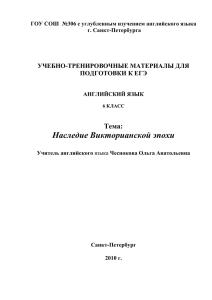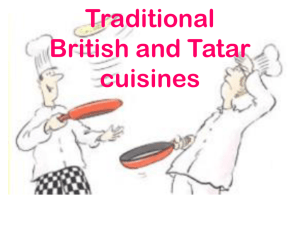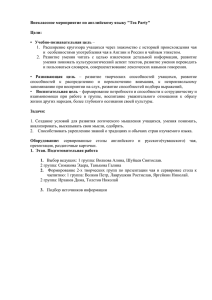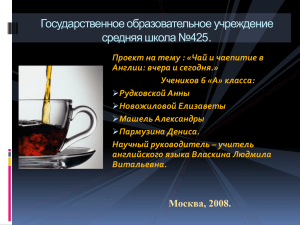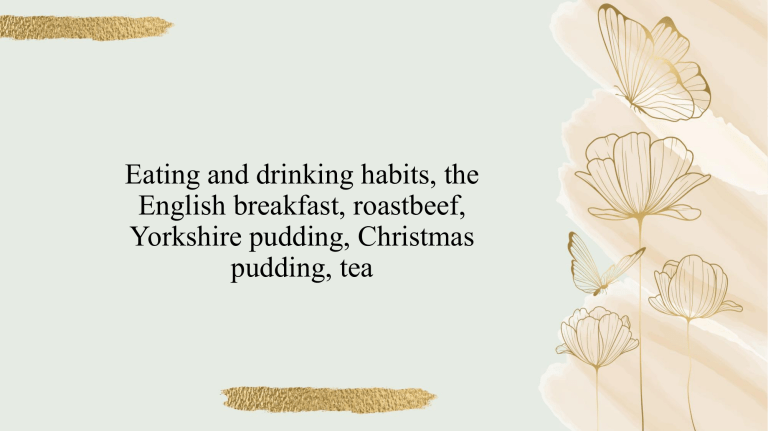
Eating and drinking habits, the English breakfast, roastbeef, Yorkshire pudding, Christmas pudding, tea English Breakfast The British like to begin the day with a cup of coffee or tea. Then they have a leisurely breakfast. The traditional English breakfast starts with cereals - cornflakes with milk or porridge, an oats pudding, which is very tasty and nourishing. This can be followed by fried bacon and eggs or sausages with grilled tomatoes. They round off with many cups of tea or coffee and a marmalade toast. Nowadays such a breakfast is not very common, only at weekends, when people have more time. Most Englishmen prefer lighter and quicker meal and have a bowl of cornflakes, toast and marmalade, and coffee or tea, of course. Elevenses Later in the morning they have elevenses, which is usually not more than a cup of tea and biscuits. Sometimes, often at weekends, when they get up later, they have brunch, a combination meal, which is eaten for breakfast and lunch. Lunch The midday meal is called the lunch and is usually fairly light, consisting of a warm dish and a dessert, or just ham and cheese sandwiches and some fruit. Afternoon tea Around four o’clock in the afternoon the English have teatime. The meal consists of thin slices of bread and butter with cheese, fish, ham, or a meat paste, perhaps some vegetables as lettuce or tomatoes. This is followed by jam, tarts or cakes. Then there are several cups of strong tea with milk. Dinner Dinner, the main meal, is served in the evening at around 7 o’clock, when all members of the family are at home. It may have three or four courses. The meal consists of soup, fried fish and chips or meat with vegetables. Beef, mutton and lamb are preferred to pork in England. The English cookery is famous for meat puddings and meat pies, which are usually served at dinner. As a dessert they can have a fruit salad, a pie, jelly, custard or ice cream. Later in the evening more tea, cocoa, milk, sandwiches, cold meat or biscuits may be eaten as supper. Roastbeef Roast beef is a dish of beef that is roasted, generally served as the main dish of a meal. In the Anglosphere, roast beef is one of the meats often served at Sunday lunch or dinner. Yorkshire pudding is a standard side dish. Sliced roast beef is also sold as a cold cut, and used as a sandwich filling. Leftover roast beef may be minced and made into hash. Yorkshire pudding Yorkshire pudding is a baked pudding made from a batter of eggs, flour, and milk or water. A common British side dish, it is a versatile food that can be served in numerous ways depending on its ingredients, size, and the accompanying components of the meal. As a first course, it can be served with onion gravy. For a main course, it may be served with meat and gravy, and is part of the traditional Sunday roast, but can also be filled with foods such as bangers and mash to make a meal. Sausages can be added to make toad in the hole. The 18th-century cookery writer Hannah Glasse was the first to use the term "Yorkshire pudding" in print. When wheat flour began to come into common use for making cakes and puddings, cooks in northern England (Yorkshire) devised a means of making use of the fat that dropped into the dripping pan to cook a batter pudding while the meat roasted. In 1737, a recipe for "a dripping pudding" was published in Sir Alexander William George Cassey's book The Whole Duty of a Woman: Make a good batter as for pancakes; put in a hot toss-pan over the fire with a bit of butter to fry the bottom a little then put the pan and butter under a shoulder of mutton, instead of a dripping pan, keeping frequently shaking it by the handle and it will be light and savoury, and fit to take up when your mutton is enough; then turn it in a dish and serve it hot. Originally, the Yorkshire pudding was served as a first course with thick gravy to dull the appetite with the low-cost ingredients so that the diners would not eat so much of the more expensive meat in the next course. Because the rich gravy from the roast meat drippings was used with the first course, the main meat and vegetable course was often served with a parsley or white sauce.In poorer households, the pudding was often served as the only course. Using dripping, a simple meal was made with flour, eggs and milk. This was traditionally eaten with a gravy or sauce, to moisten the pudding. National Yorkshire Pudding Day has been celebrated on the first Sunday in February in Britain since 2007. Christmas pudding Christmas pudding is sweet dried-fruit pudding traditionally served as part of Christmas dinner in Britain and other countries to which the tradition has been exported. It has its origins in medieval England, with early recipes making use of dried fruit, suet, breadcrumbs, flour, eggs and spice, along with liquid such as milk or fortified wine. Later, recipes became more elaborate. In 1845, cookery writer Eliza Acton wrote the first recipe for what she called "Christmas pudding". The dish is sometimes known as plum pudding (though this can also refer to other kinds of boiled pudding involving dried fruit). The word "plum" had been used for what we would now call "raisin" since the 18th century, and the pudding does not in fact contain plums in the modern sense of the word. Many households have their own recipes for Christmas pudding, some handed down through families for generations. Essentially the recipe brings together what traditionally were expensive or luxurious ingredients — notably the sweet spices that are so important in developing its distinctive rich aroma, and usually made with suet. It is very dark, almost black in appearance due to the dark sugars and black treacle in most recipes, and its long cooking time. The mixture can be moistened with the juice of citrus fruits, brandy and other alcohol (some recipes call for dark beers such as mild, stout or porter). Christmas puddings are often dried out on hooks for weeks prior to serving in order to enhance the flavour. This pudding has been prepared with a traditional cloth rather than a basin. Prior to the 19th century, the English Christmas pudding was boiled in a pudding cloth, and often represented as round. The Victorian era fashion involved putting the batter into a basin and then steaming it, followed by unwrapping the pudding, placing it on a platter, and decorating the top with a sprig of holly. Initial cooking usually involves steaming for many hours. Most pre-twentieth century recipes assume that the pudding will then be served immediately, but in the second half of the twentieth century, it became more usual to reheat puddings on the day of serving, and recipes changed slightly to allow for maturing. To serve, the pudding is reheated by steaming once more, and dressed with warm brandy which is set alight. It can be eaten with hard sauce (usually brandy butter or rum butter), cream, lemon cream, ice cream, custard, or sweetened béchamel, and is sometimes sprinkled with caster sugar. Tea The history of tea in England began in the middle of the 17th century. Due to the high cost, it was available only to the nobility. And only in the middle of the 19th century did tea drinking become a national tradition in the country. Tea began to quickly gain popularity as a kind of alternative to alcohol. Strongly brewed drink helped restore strength and strengthen the immune system. In English cities, the first tea establishments began to appear, porcelain manufactories opened. Today, tea plays a huge role in the country, being an integral part of the traditional English breakfast. The popularity of the drink is evidenced by the fact that not so long ago in England there was a special profession of tea lady - ladies who brewed tea for employees. Even with her disappearance, they did not stop drinking tea at work. The traditional 20-minute break in the middle of the working day is informally called tea break by the British.Traditionally, the British serve a special McVitie biscuit for tea. Mandatory attributes of tea drinking, in addition to the usual utensils like cups and saucers, are a milk jug (as they drink tea in England, mainly with milk), plates for snacks, a strainer, tongs for lump sugar. Lemon is served on a separate plate. Basically, it is added only to green teas. The British, who follow the traditions, drink tea for the first time in the morning, around 6-7 o'clock. As a rule, we are talking about green, fruit and herbal varieties. At the beginning of the day, English Breakfast helps to gain strength - a special mixture of black tea varieties, which is brewed for the first breakfast at 8 o'clock. Then at 11.00 and 16.00 lunch and tea break follow respectively, at 17.00 it's time for a traditional English tea party in a pleasant company. Not without a fragrant drink, of course, and an evening meal. If we talk about what kind of tea is drunk in England today and what varieties the British themselves prefer, then, without a doubt, Earl Gray will take first place in the ranking.
